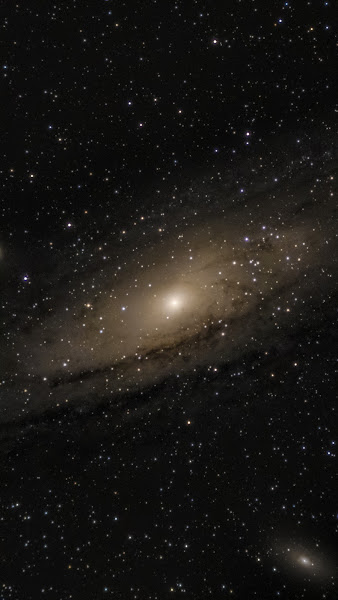ZWO has released the much-anticipated mosaic capability for the Seestar S50. One of the limitations of the S50 is the limited field of view, which meant it was not possible to get all of the Andromeda Galaxy in one image. I tried out the mosaic last night, the third time I have aimed the Seestar at Andromeda, and got mixed results.
Third attempt at M31, mosaic, last night
When you set up the mosaic, it tells you the target exposure time, which at maximum magnification (for lack of a better word) is 1.9 hours. I set it running but stopped it after 37 minutes of exposure time because I wasn't sure it was in focus. In looking at what was produced, I was correct to stop it. There is one rule I need to follow with the Seestar: On the first target of the night, before letting the Seestar start imaging, always always always refocus. I'm estimating that 37 minutes actually took more than twice that time due to lag between images and dropped frames, so that time was wasted. Then for some reason it told me Andromeda was out of range (which I don't believe was true) and wouldn't let me restart, so I shot the Pelican Nebula, 49 minutes exposure time. I'll replace the murky image I posted back in September with image #4 below. Then it let me restart the Andromeda mosaic at a little bit after 11 pm, once again advising 1.9 hours of exposure.
It ran for almost six hours. I woke up at 4:49 and stopped it, figuring it had plenty. But total exposure time only registered at 107 minutes. The center is reasonably good because lots of images contributed to the middle of the stack, but the edges are noisy because fewer images are stacked. I found out about the mosaic capability from a YouTube video done by Cuiv, The Lazy Geek, a guy with a weird European accent who lives in Tokyo. He said it is not practical to save all of the individual 10-second images and restack them because (unlike "normal" images) the telescope is not centered on the object all of the time. I don't know if he was referring to stacking in the Seestar app or a different program, but I followed his advice and turned off the "Save each frame in enhancing" option. Now I'm wondering if I should have kept it on and tried restacking inside the app, which is what I usually do. Maybe it would take 10 hours to restack, maybe it wouldn't work, I don't know. The only other thing I can think of doing differently with the setup is making sure the scope is level. The little tripod has a bubble level, which is completely covered when the scope is mounted. The tripod is so short that it is difficult to adjust. I might put the scope on my big tripod and see if that is any easier.
I would try again tonight if I could, but the weather forecast doesn't look good for another attempt any time soon. It seems I would need to devote 10 hours to getting 1.9 hours of exposure time to avoid some of the noise. I'm also wondering how often the mosaic capability will be useful. I think every Seestar owner's reaction on hearing the news was, "I'll reshoot Andromeda." Except for Andromeda, I don't know of any galaxies that are too big for the Seestar's field of view. For example, I would like a tighter view of the Whirlpool Galaxy, not a wider one. There are a few nebulae and maybe some star clusters that might benefit from mosaic. I saw Orion shining high last night around midnight, and I might take another crack at the Orion Nebula. I don't believe 2x is necessary, but I would like just a slightly larger field of view.
ZWO just announced a new Seestar, designated the S30, that has two lenses. The main lens is wider than the S50's, and there is a secondary telephoto lens. How that second lens works is a bit murky in what I have read. The only examples they showed were of terrestrial images, and I don't need that capability. The price apparently is $350, $150 cheaper than the S50. I don't think this is a "must-have" replacement or second scope, especially considering I haven't explored the capabilities of the new stuff I've recently acquired for my real telescope. But it's nice to see ZWO is expanding this line.
So, let's compare. Image #1 is last night's attempt, processed from the automatically-produced JPG. I used Siril just to remove the green cast; other than that I used the Photoshop RAW filter. Some of the noisy parts of the image were cropped from the sides and top. I kept the galaxy M110 in the frame at the bottom, and noise is very visible in that part of the image. I tried processing the telescope-standard FIT file in Siril, which produced an image which had a bit more detail but a lot more noise. (BTW, I wish Seestar would save its automatic image as a 16-bit TIF rather than an 8-bit JPG.) Image #2 is my most recent attempt from October 2, which was an improvement over my very first attempt from September 27, image #3. And, as mentioned, #4 is the new version of the Pelican Nebula. I know the three Andromeda images are all different dimensions and are difficult to compare. Primary blame goes to ZWO's bizarre phone-centric decision to shoot everything in portrait mode.

















































